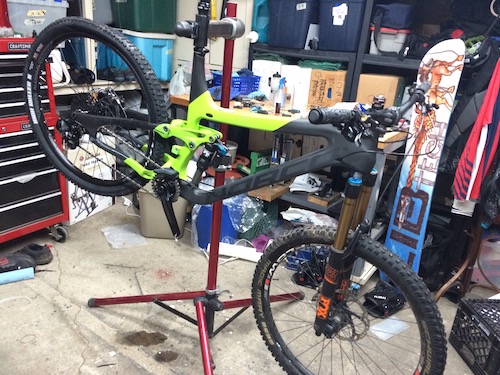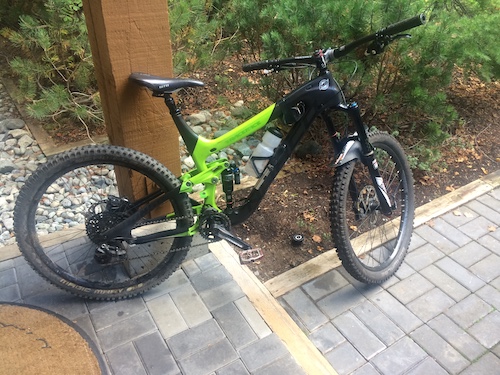I was super excited to get a new trail bikes, and on a very rainy day, Cory dropped it off and I built it up immediately. The Norco Range had more travel than my ForceX and was built a bit beefier. Upon first building it up and riding it on the street, I was a bit worried on how it would pedal. With the shock in open mode, it bounced quite a lot while pedaling. Luckily the lockout seemed quite strong and I was pleasantly surprised on my first climb up to ride Bobsled in the snow.

I had the bike built up in many different configurations. C4 was supported by Sram, so I wanted to run those components, but I didn’t have the money right away to buy those components, so I had to make do with what I had. The bike came stock with not the best brakes of fork, so I swapped those out for the ones that were off my ForceX. Eventually, I was able to buy a Rockshox Lyric and I traded the stock Fox Float X shock for a Rockshox Monarch+. It was cool to see the differences between the two brands back to back on the same bike, which I hadn’t experienced before. The Lyric was definitely smoother than the 36, but similar to the Boxxer, it didn’t have as much mid travel support. Adding more air pressure and tokens helped this. I didn’t notice a whole lot of difference between the Fox rear shock and the Rockshox. Both were smooth, had 3 modes to ride in (climb, trail, decent), and didn’t bottom out harshly or have any issues with breaking traction or sliding out where they shouldn’t have.

This was also the first bike where I used a carbon handlebar. In my opinion, the potential negatives outweigh the positives in this situation going forward. I never had any problems with this carbon bar, and I did like how light and stiff it was, but there was always that fear in the back of my mind that I had over torqued the stem or brake mount bolts and the bar might break. I know that plenty of people use them and prefer them to aluminum and say that if you set everything up right, they aren’t any more likely to break than an aluminum bar, but I’d rather not take that chance when so much is on the line. I’m not a weight weenie.
I did really like how the hub spacing was the same on the Range and the Aurum. This meant that if I wanted to ride my Range in the bike park, I could swap my stronger DH wheel onto the Range so that I wouldn’t damage my lighter weight trail bike wheel, and I always had a spare if anything went wrong on either bike.
The only quirk I can mention for this bike is how tall this it was. I chose an XL frame, because that’s what Norco recommends for my height. My brother has a Large frame in the exact same bike, and after riding his, I noticed how low to the ground his was compared to mine. The XL had a very high standover height and the seat tube was very long, meaning I couldn’t get as low in the corners or in technical sections as I would have liked. After riding my brothers I realized that it wasn’t too much shorter and that I would have preferred the lower centre of gravity that it put me in, rather than the extra length that the XL provided. Other than that, the only complaint I had was with some of the parts that came on the lower spec build.
The dropper post was not the greatest. It was very slow to come up and the lever felt cheap and was hard to use when you needed it. It also had a high profile, which means that the seat was actually higher than it would be compared to a different dropper post. Unfortunately the seat tube sizing wasn’t the same as my ForceX, meaning I couldn’t use that dropper post, which I preferred. Fortunately with some trading/flipping of bikes, I acquired a Specialized dropper post, which had a lower profile. Unfortunately, this dropper post was air operated and had a leak, so it would only really work if you filled it with air every day. I didn’t want to do this every time I went riding, so sometimes I would just deal with having to manually pull the post up when I needed it. For me, this was better than having the seat higher on the downhills and justified me using that seat post.
